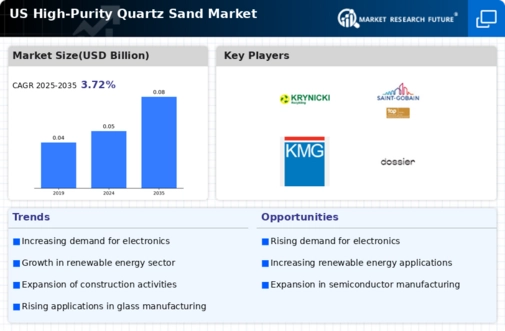The high purity quartz sand market is characterized by a competitive landscape that is increasingly shaped by innovation, strategic partnerships, and a focus on sustainability. Key players such as Unimin Corporation (US), The Quartz Corp (US), and U.S. Silica Holdings, Inc. (US) are actively pursuing strategies that enhance their market positioning. Unimin Corporation (US) has been focusing on expanding its product portfolio to cater to the growing demand in the semiconductor and solar industries, indicating a shift towards high-value applications. Meanwhile, The Quartz Corp (US) emphasizes its commitment to sustainable mining practices, which not only enhances its brand reputation but also aligns with the increasing regulatory pressures for environmentally responsible operations. U.S. Silica Holdings, Inc. (US) appears to be leveraging digital transformation initiatives to optimize its supply chain and improve operational efficiency, thereby enhancing its competitive edge.
The business tactics employed by these companies reflect a moderately fragmented market structure, where localizing manufacturing and optimizing supply chains are pivotal. The collective influence of these key players suggests a dynamic interplay of competition, where innovation and operational efficiency are paramount. As companies strive to differentiate themselves, the focus on high purity quartz sand applications in advanced technologies is likely to intensify, further shaping the competitive environment.
In November 2025, Unimin Corporation (US) announced a strategic partnership with a leading semiconductor manufacturer to supply high purity quartz sand for next-generation chip production. This collaboration is expected to enhance Unimin's market share in the semiconductor sector, which is experiencing robust growth. The strategic importance of this partnership lies in its potential to solidify Unimin's position as a key supplier in a high-demand market, thereby driving revenue growth.
In October 2025, The Quartz Corp (US) launched a new line of eco-friendly high purity quartz products aimed at the solar energy sector. This initiative not only reflects the company's commitment to sustainability but also positions it favorably in a market that increasingly values environmentally responsible products. The introduction of these products is likely to attract new customers and strengthen existing relationships with environmentally conscious clients.
In September 2025, U.S. Silica Holdings, Inc. (US) implemented an advanced AI-driven analytics platform to enhance its operational efficiency and supply chain management. This technological advancement is expected to streamline operations and reduce costs, thereby improving profitability. The strategic significance of this move lies in its potential to provide U.S. Silica with a competitive advantage in a market where efficiency and cost-effectiveness are critical.
As of December 2025, the competitive trends in the high purity quartz sand market are increasingly defined by digitalization, sustainability, and technological integration. Strategic alliances are becoming more prevalent, as companies recognize the value of collaboration in enhancing their market positions. Looking ahead, the competitive differentiation is likely to evolve from traditional price-based competition to a focus on innovation, technology, and supply chain reliability. This shift underscores the importance of adapting to market demands and leveraging technological advancements to maintain a competitive edge.















Leave a Comment